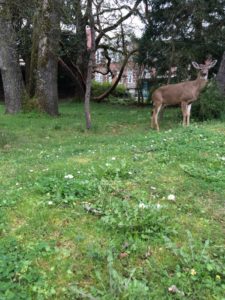A Camosun student and current Camosun instructors have gotten involved in a collaborative urban deer management project through the Urban Wildlife Stewardship Society (UWSS).
Camosun Environmental Technology co-op student Chelsey Mercer says that she’s gotten to know the deer and their habits through the camerawork she’s done for the project. Some of it has been surprising: she claims there are probably fewer than 100 deer in Oak Bay, for example, much fewer than most people would think.
“They actually have these incredible, complex social systems,” says Mercer. “Certain does will hang out with other does because they enjoy their company, even taking care of each other’s young. They will stay in the same areas, too. One thing I tell the public when I interact with them is that when people are sure they are seeing a thousand deer, what is actually happening is that the deer’s colouring changes through the seasons, and you will be seeing the same doe over and over.”
Mercer emphasizes the importance of “compassionate conservation,” as does Camosun Environmental Technology instructor Annette Dehalt—who is also the UWSS vice president.
“With people thinking there are too many deer, we are going to go with immunocontraception over a cull,” says Dehalt. “We definitely wanted to choose a non-lethal method, more sustainable. With the immunocontraception, it is basically a vaccine which prevents the egg to be receptive to the sperm, and so it prevents them from having young.”
Dehalt says that the program came about after deer complaints in Oak Bay in 2015 led to a controversial cull.
“There was no real data out there on how many deer there actually were,” says Dehalt. “Some of my students in the Environmental Tech program had done moving line transit studies, and there were groups who did their capstone projects on urban deer, but they still hadn’t done a government study.”
Mercer’s involvement in this goes beyond her work in the field; she’s become a director on the UWSS board.
“When a discussion happens about how something is going to be done, I get to be there,” she says, “which for someone of my age, and having just come through Camosun, is just really amazing to have that opportunity.”
The subject of deer is a controversial one in Victoria; one of the main points of contention is to cull or not to cull. For Mercer, it comes back to compassionate conservatism, which also, she says, has an added benefit on the data.
“Making sure that you are putting the animal first and understanding that every manipulation that we do can affect the scientific data as well,” she says. “So, less impact means less adverse effects to the animal, but it also means that we’re getting quality data.”
Dehalt says that the black-tailed deer are a native species to Victoria, and humans need to live with them peacefully.
“They were here long before the white settlers planted tulips and roses,” she says. “That is something we must remember, that we are finding a way to co-exist. We need to include as much wildlife as possible, from birds to mammals, if management is perceived to be a necessity. It has to be done as humanely as possible.”
Correction: The last quote of this story was originally attributed to Chelsey Mercer due to an editing error; Annette Dehalt actually said it. We apologize for the error.

